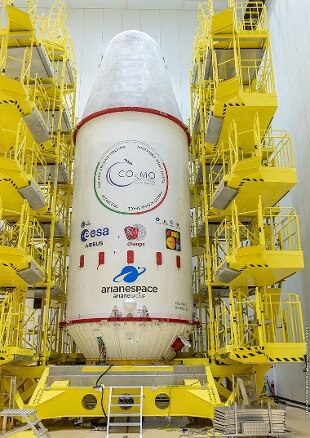- French Guiana: Tuesday doubly important launch for Italy
Share
by Andrea Bettini 15 December 2019In the Kourou space base the Soyuz carrier is already in position. The approach to the launch on Tuesday morning proceeds as planned: at 9.54 am Italian time, 5.54 am on the South American coast, the giant almost 50 meters high will start the engines and fly out of the atmosphere. It will be the ninth and last departure of the year from French Guiana and the world of Italian space awaits you with anxiety because the cargo is precious: two missions in which Italy is at the forefront.The second generation of COSMO-SkyMed
The Soyuz launcher will place five satellites in orbit on Tuesday. The largest is the new element of the COSMO-SkyMed constellation of ASI and the Ministry of Defense. It is entirely Italian and will have the task of observing our planet with a level of detail greater than the four already operational, launched between 2007 and 2010. It will be the first step for the renewal of the constellation. Built by Thales Alenia Space, it will use radar technologies that will allow it to make observations even with the cloudy sky or in the middle of the night.
"Let's go back to the satellites that are now obsolete - explains ASI's Technology and Engineering unit manager Roberto Formaro - From a technical point of view this type of satellite gives us the possibility to make a series of observations of our planet and enable services such as change detection, land management of maritime flows management ”.
With CHEOPS, Europe studies extrasolar planets
Smaller, but with equally great potential is the European Space Agency's CHEOPS satellite. Instead of looking at the Earth, it will turn its instruments towards the planets in orbit around distant stars. The result of a partnership between ESA and 11 European countries, it also had the support of the ASI. His telescope was designed by researchers from the INAF of Padua and Catania and produced by the Italian industry with Leonardo, Media Lario and Thales Alenia Space.
"The basic questions are: are we alone? Where do we come from? The study of exoplanets will help us better understand the formation of the planets and therefore also of the Earth - says the director of ESA scientific programs, Guenther Hasinger - We know about 4 thousand exoplanets. Now we need to characterize them: CHEOPS will study some of the most interesting planets already discovered to understand how they are made “.
Three small satellites
The launch on Tuesday will also take the small satellites OPS-SAT, EyeSat and ANGELS into orbit. OPS-SAT, from ESA, is a first: it will function as a platform to test the satellite control software directly in orbit. EyeSat and ANGELS are instead of French manufacture and will have the task, respectively, of studying the Milky Way and leading the way to a constellation of nanosatellites.

